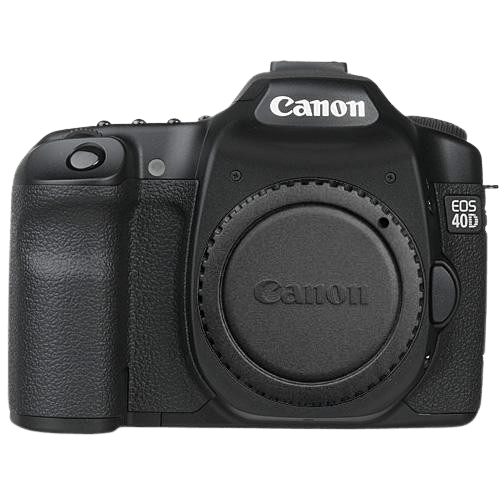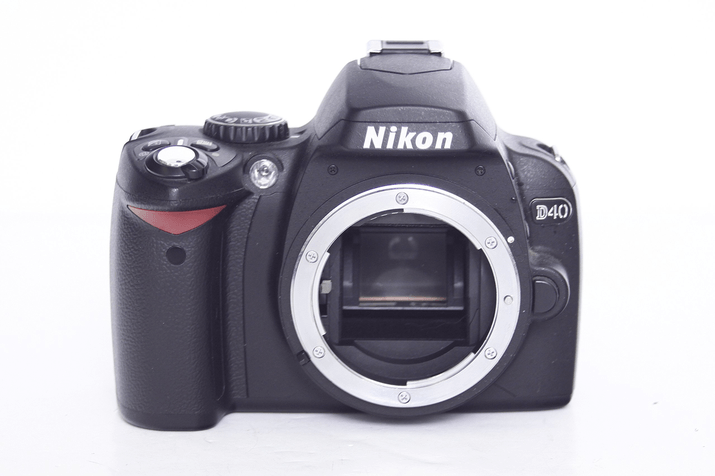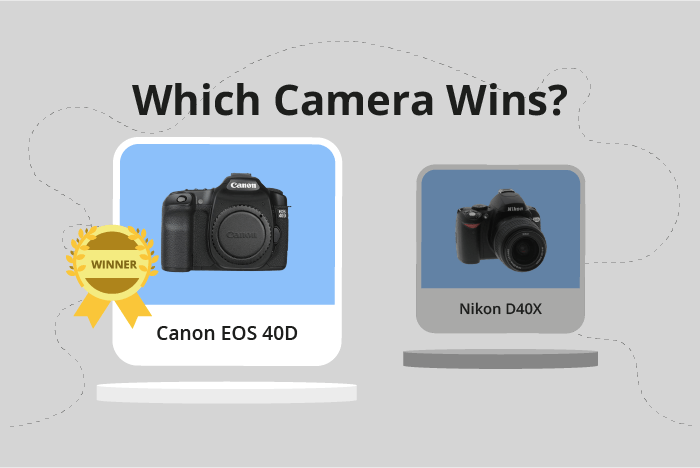Canon EOS 40D vs Nikon D40X Comparison
Canon EOS 40D

Nikon D40X

The Canon EOS 40D outperforms the Nikon D40X with a score of 42/100 compared to 33/100. Both DSLR cameras were released in 2007, with the Canon EOS 40D announced on August 20th and the Nikon D40X on March 6th. They share similar launch prices, with the Canon EOS 40D priced at $899 and the Nikon D40X at $998.
The Canon EOS 40D has a larger body, measuring 146 x 108 x 74mm and weighing 822g (1.81lbs), while the Nikon D40X is more compact, with dimensions of 124 x 94 x 64mm and a weight of 522g (1.15lbs). The Canon EOS 40D’s higher score signifies its superior performance in various aspects compared to the Nikon D40X.
On the other hand, the Nikon D40X’s smaller size and lighter weight make it more portable and convenient to carry around. Although it has a lower score, this feature may appeal to photographers who prioritize a compact design.
Taking all factors into consideration, the Canon EOS 40D stands out as the better camera, offering enhanced performance and features. However, the Nikon D40X’s compact size and lighter weight may still attract photographers who value portability.
Canon EOS 40D vs Nikon D40X Overview and Optics
The Canon EOS 40D outperforms the Nikon D40X in optics with a score of 45/100 compared to 40/100. Both cameras share some common specifications, such as 10.1 and 10 megapixels, APS-C sensor size, and no image stabilisation. However, certain features set them apart, making one better than the other in specific aspects.
The Canon EOS 40D excels in shooting speed, boasting 6.5 frames per second compared to the Nikon D40X’s 3 frames per second. This makes the EOS 40D more suitable for capturing fast-moving subjects or continuous shooting. Additionally, the EOS 40D has a slightly higher DXOMARK score for its sensor (64) than the D40X (63), indicating marginally better image quality.
On the other hand, the Nikon D40X has a few advantages over the Canon EOS 40D. The D40X uses a CCD sensor, known for producing high-quality images with lower noise levels, while the EOS 40D uses a CMOS sensor. The Nikon D40X also uses the Expeed processor, which is efficient in terms of power consumption and noise reduction.
When comparing lens mounts, the Canon EOS 40D uses the Canon EF-S mount, while the Nikon D40X uses the Nikon F DX mount. Both mounts offer a wide range of compatible lenses, making either camera a suitable choice for photographers looking to expand their lens collection.
Taking all factors into consideration, the Canon EOS 40D has a slight edge over the Nikon D40X in terms of optics, primarily due to its faster shooting speed and marginally better sensor quality. However, the Nikon D40X may be more appealing to photographers who prioritize image quality and noise reduction. Ultimately, the choice between these two cameras depends on individual preferences and shooting requirements.
Canon EOS 40D vs Nikon D40X Video Performance
When examining the video capabilities of the Canon EOS 40D and the Nikon D40X, it is important to note that neither camera possesses video functionality. As a result, no comparison can be made in this aspect. The absence of video capabilities does not affect their overall quality, but it is a feature to consider when evaluating these cameras.
Canon EOS 40D vs Nikon D40X Features and Benefits
The Canon EOS 40D outperforms the Nikon D40X in the features department, scoring 36/100 compared to the Nikon’s 17/100. Despite the difference in scores, both cameras share some common specifications. Neither camera has a touchscreen, flip screen, GPS, WIFI, or Bluetooth. However, they both have a screen resolution of 230,000 dots.
The Canon EOS 40D excels in screen size, offering a 3-inch display compared to the Nikon D40X’s 2.5-inch screen. This larger screen provides a better view of images and menus, leading to an enhanced user experience.
On the other hand, the Nikon D40X does not have any specific advantages over the Canon EOS 40D in terms of features. The only similarity is the screen resolution, but the Canon EOS 40D still comes out on top with its larger screen size.
In examining these points, it is clear that the Canon EOS 40D offers superior features compared to the Nikon D40X. The larger screen size is a significant advantage, providing a better user experience for photographers. Meanwhile, the Nikon D40X fails to outshine the Canon EOS 40D in any specific feature, making the Canon EOS 40D the better choice when considering features alone.
Canon EOS 40D vs Nikon D40X Storage and Battery
The Canon EOS 40D wins in the storage and battery category with a score of 35/100, while the Nikon D40X scores 27/100. Both cameras have one memory card slot, and neither offers USB charging. The Canon EOS 40D accepts Compact Flash (Type I or II) memory cards, while the Nikon D40X uses SD/SDHC cards.
The Canon EOS 40D outperforms the Nikon D40X in battery life, providing 800 shots per charge with its BP-511 battery, compared to the Nikon D40X’s 520 shots using the EN-EL9 battery. This advantage makes the Canon EOS 40D more suitable for extended shooting sessions without needing to replace or recharge the battery.
The Nikon D40X does not have a clear advantage in storage and battery performance over the Canon EOS 40D. However, its use of SD/SDHC cards may be more convenient for some users, as these cards are more widely available and versatile than the Compact Flash cards used by the Canon EOS 40D.
Considering the storage and battery aspects, the Canon EOS 40D is the better choice due to its longer battery life, allowing for more shots per charge. The Nikon D40X falls short in this area, but its use of SD/SDHC cards may appeal to some users.
Canon EOS 40D vs Nikon D40X – Our Verdict
Are you still undecided about which camera is right for you? Have a look at these popular comparisons that feature the Canon EOS 40D or the Nikon D40X:

